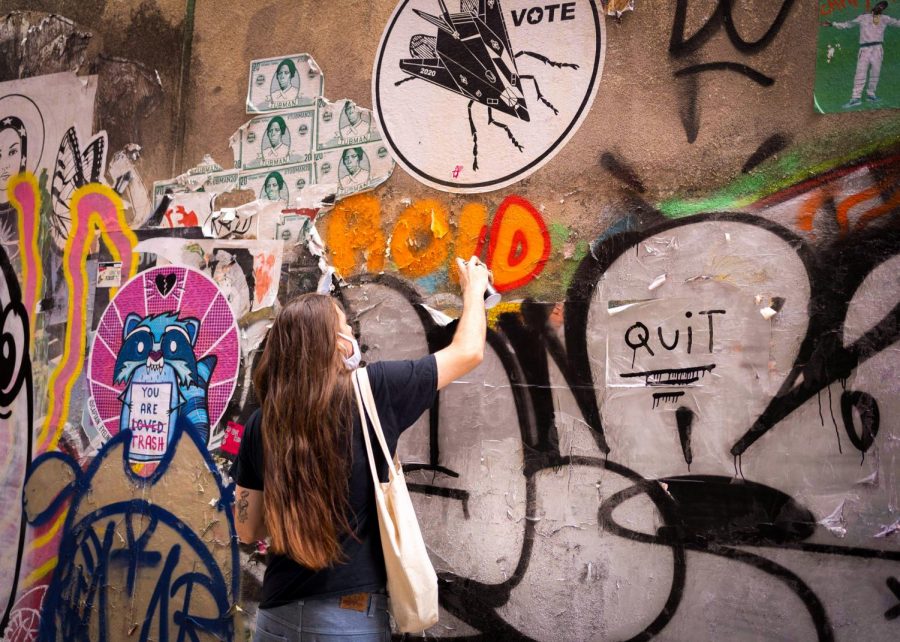The NYPD’s graffiti cleanup fails at building trust with New Yorkers
June 24, 2021
The New York City Police Department has recently launched a “Graffiti Cleanup” campaign with hopes to “rebuild relationships” with city communities. In an uncharacteristic turn of events, it seems that NYPD officers shot but missed their target with this one.
The campaign was first launched in April 2020 and comes as a response to the 6,078 graffiti complaints reported throughout 2020. Since then, members of the NYPD have been working alongside community volunteers in painting over graffiti in every precinct of the city.
According to the NYPD, many benefits come with this new initiative.
“This is how we build bridges and build trust . . . When you have relationships and they have difficult times . . . you work together. That’s how you usually rebuild relationships,” Chief of Community Affairs Jeffrey Maddrey said.
The NYPD will need a lot more than a few paintbrushes to “build trust” with communities. A 2020 Siena Poll shows that a large portion of New Yorkers believe that people of color in New York are treated unfairly by the criminal justice system.
Police officials have also adopted a sudden interest in the city’s urban appearance and have stated that the new cleanup initiative is aimed to “improve the look” of neighborhoods and bring some “positivity and beauty” to these spaces.
Due to last year’s budget cuts from the Graffiti-Free NYC program, the NYPD has been unable to task members graffiti removal during the COVID-19 pandemic. As deserted commercial streets offered thousands of blank canvases for graffiti artists, reports of vandalism and graffiti began to rise over the past year.
The images flooding every precincts’ Twitter page, showcasing community volunteers painting side-by-side NYPD officers, is not indicative of the police departments’ efforts to rebuild trust with citizens. At best, it highlights the NYPD’s ability to make the best out of a bad situation.
By depending on unskilled volunteers and lacking the due diligence required to undertake such a project, the graffiti cleanup team was bound to make a mistake. In less than two months, it received its first lawsuit.
Brooklyn-based artist Michael McLeer, better known by the moniker Kaves, has filed a class- action lawsuit against the NYPD for having painted over his mural.
McLeer created the mural 13 years ago with permission from both the property owner and tenant of the building. He has since made more than $9,000 per licensing agreement as his work has been featured in several graffiti books, TV shows and advertising campaigns.
The NYPD’s 84th precinct tweeted a series of images capturing their destruction of McLeer’s mural with the caption, “Let’s keep working together to keep NYC graffiti-free!”
McLeer said that “staffing the cleanup with volunteers was not an earnest attempt to connect with the community” and that the NYPD has taken a “heightened stance against graffiti messages that have an anti-police sentiment.”
The comforting narrative that paints the NYPD as being dedicated to beautifying neighborhoods and working in the spirit of comradery shifts focus from the police department’s active efforts to silence criticism.
On April 4, demonstrators marched into Brooklyn’s 84th precinct and demanded that the NYPD fire Officer Artem Prusayev for pulling a gun on a Black Lives Matter protester in January. After the demonstration, one protester sprayed, “Stop Killing Black People,” on the Manhattan Bridge.
Since then, two individuals have been wanted for graffiti and criminal mischief and the NYPD has yet to take any action against Prusayev.
The police department has repeatedly turned a blind eye to its failures while scrambling for ways to strengthen its relationship with New Yorkers. It needs not look any further than the Manhattan Bridge for ideas. The NYPD is not unique, however, when it comes to mismanaging priorities.
Two days after the demonstration, New York City Mayor Bill de Blasio announced in a press conference the creation of New York’s new City Clean Up Corps.
The creation of the Corps is set to add 10,000 new jobs and will hire from 10 different city agencies. Despite the added resources, the new Corps do not intend to waste any time filtering between New York’s iconic street art and hateful graffiti. Their goal remains clear: to eradicate graffiti.
New York’s mayoral office is unlikely to shift its views on graffiti any time soon.
Brooklyn Borough President Eric Adams, who is currently leading the mayoral race, shares the same sentiment as de Blasio on the topic. The former police officer has vowed to scrub out “defacements,” as he believes that graffiti only allows lawlessness to spread, a logic that echoes with the history of “broken window” policing.
Baruch College professor Sociology and Anthropology Gregory Snyder, who authored the critically acclaimed book, Graffiti Lives, commented on the matter.
“They just never learn,” he said. “The same people tried the same thing at 5pointz 8 years ago and lost the case. If you’re looking to paint over some name-based vandalism in New York, you can start with the one on Fifth Avenue. It goes by Trump Tower.”







